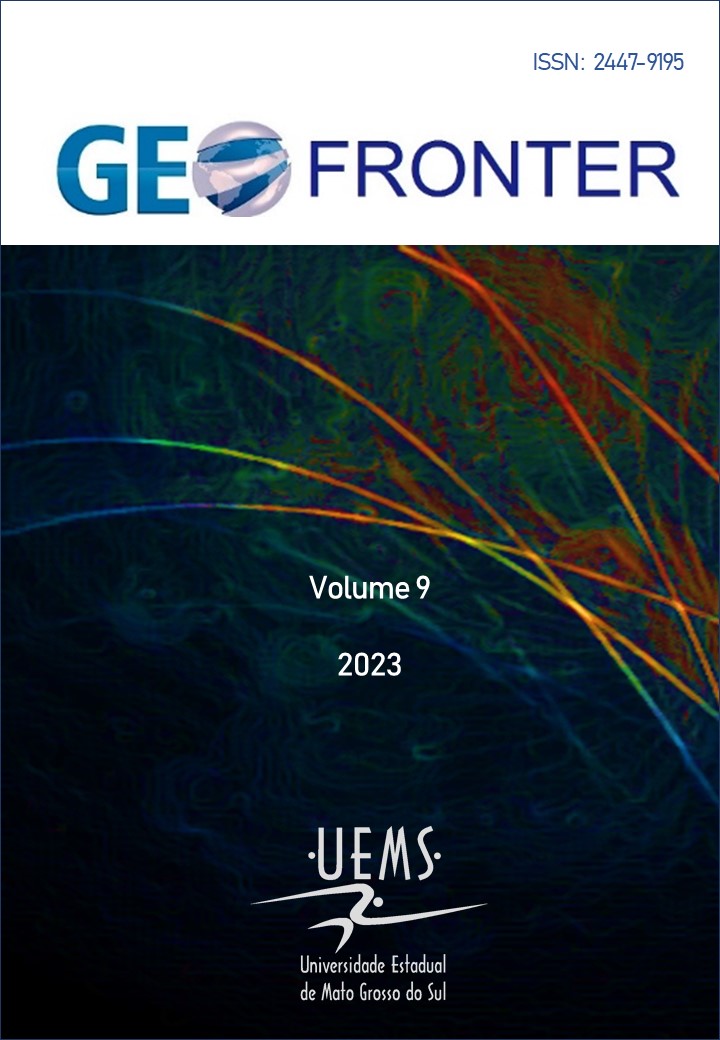AVALIAÇÃO DA QUALIDADE AMBIENTAL DAS NASCENTES URBANAS DO CÓRREGO GAMELEIRA, CAMPO GRANDE-MS
DOI:
https://doi.org/10.61389/geofronter.v9i1.7488Keywords:
Exfiltração, Monitoramento ambiental, Recuperação, Planejamento urbanoAbstract
Urban watersheds should be areas of conservation, based on effective urban planning and their sources should be environmental preservation areas, according to legislative provisions. The physical and natural specificities of these areas delimited by topography enable identifying and spatializing the origin of the water flow of a given region. Following the intention of creating actions that subsidize territorial planning in an urban basin, the analysis begins with the identification and spatialization of water origin. By allocating areas containing dense and native arboreal vegetation, the Permanent Preservation Areas (PPAs) are determined, according to Brazil (2012). This study aims to contribute to the identification of water sources located in the Urban Watershed of Gameleira stream, in the municipality of Campo Grande-MS, highlight the importance of morphometric analysis, map surface runoff in drainage basins, and identify occupational processes. The results made it possible to classify the water sources coded in P01-GAM and P03-GAM with Attention Level 3 and the source P02-GAM with Attention Level 5. The classification shows that Attention Level 3 alerts to the need for corrective actions to correct impacts on PPAs and that Attention Level 5 is with the preserved PPAs, with the caveats for the proper maintenance of environmental systems.
References
BARBOSA, E. H. B.; IDE, C. N.; GONÇALVES, F. V. Comparison of Rain Erosivity Models (Factor R) Using Statistical Analysis. Anuário do Instituto de Geociências (UFRJ. IMPRESSO), v. 41, p. 133-140, 2018. DOI: https://doi.org/10.11137/2018_2_133_140
BRASIL. Resolução CONAMA nº 303. Dispõe sobre parâmetros, definições e limites de Áreas de Preservação Permanente. Diário Oficial da União, Brasília, DF, 20 mar. 2002.
BRASIL. Lei nº 12.651, de 25 de maio de 2012. Dispõe sobre a proteção da vegetação nativa. Diário Oficial da União, Brasília, DF, 28 mai. 2012.
CALHEIROS, R. de O.; TABAI, F. C. V.; BOSQUILIA, S. V.; CALAMARI, M. Preservação e Recuperação de Nascentes. Piracicaba: Comitê das Bacias Hidrográficas dos Rios PCJ - CTRN, p. 40, 2004.
CAMPO GRANDE (Município). Plano Diretor de Desenvolvimento Urbano e Ambiental de Campo Grande. Campo Grande, MS, 05 dez. 2018.
CAMPO GRANDE (Município). Carta Geotécnica. Campo Grande, MS, 1991. Disponível em: http://www.campogrande.ms.gov.br/planurb/downloads/carta-geotecnica-mapas-formato-shape/.
COELHO NETO, A. L. Hidrologia de encosta na interface com a Geomorfologia. In: GUERRA, A. J. T; CUNHA, S. B. Geomorfologia: uma atualização de bases e conceitos. Editora Bertrand Brasil. Rio de Janeiro, 1994, 458 p.
EMPRESA BRASILEIRA DE PESQUISA AGROPECUÁRIA - EMBRAPA. Serviço Nacional de Levantamento e Conservação de Solos (Rio de Janeiro, RJ). Súmula da 10. Reunião Técnica de Levantamento de Solos. Rio de Janeiro:1979. 83p. (EMBRAPA-SNLCS. Miscelânea, 1).
ESPINDOLA JUNIOR, G.; BARBOSA, E. H. B. Análise paramétrica e uso da terra e cobertura vegetal da bacia hidrográfica do Córrego Ceroula-MS. Revista de Geografia e Ordenamento do Território (GOT), n.º 19 (junho). p. 218-234, 2020. DOI: https://doi.org/10.17127/got/2020.19.009
FELIPPE, M. F.; MAGALHÃES JUNIOR, A. P. Conflitos conceituais sobre nascentes de cursos d’água e propostas de especialistas. Geografias, Belo Horizonte, v. 9, n. 1,6 jun. 2013. DOI: https://doi.org/10.35699/2237-549X..13354
FLORENZANO, T. G. Iniciação em sensoriamento remoto. 3ed. ampl. e atual. São Paulo: Oficina de Textos, p, 71-79, 2011.
MENDONÇA, F. Diagnóstico e análise ambiental de microbacia hidrográfica – Proposição metodológica na perspectiva do zoneamento, planejamento e gestão ambiental. RA’EGA – O espaço geográfico em análise. Paraná, nº. 3. Ano III, 1999. DOI: https://doi.org/10.5380/raega.v3i0.18225
MORAES, A. J. F.; PANSONATO, A.; BARBOSA, G. N. (Org.) Procedimentos metodológicos do projeto Água para o Futuro utilizados nas nascentes urbanas de Cuiabá. Cuiabá - MT: EdUFMT, 2018. 39p.
MOREIRA, M. A. Fundamentos do sensoriamento e metodologias de aplicação. 4.ed. atual. e ampl. Ed. UFV, 422p. Viçosa-MG: 2011.
SILVA, A. B. Sistemas de Informações Geo-referenciadas: conceitos e fundamentos. Campinas, SP: Editora da Unicamp, 2003.
TUCCI, C. E. M. (Org.). Hidrologia: Ciência e Aplicação. 3ª ed. Porto Alegre, Editora da UFRGS/ABRH, 2004.
PEREIRA, P. H. V.; PEREIRA, S. Y.; YOSHINAGA, A.; PEREIRA, P. R. B. Nascentes: Análise e discussão dos conceitos existentes. Periódico Eletrônico Fórum Ambiental da Alta Paulista, v. 7, n. 2, 2011. DOI: https://doi.org/10.17271/19800827722011109
Downloads
Published
How to Cite
Issue
Section
License

This work is licensed under a Creative Commons Attribution-NonCommercial-NoDerivatives 4.0 International License.
Os autores concedem à revista GEFRONTER os direitos autorais sobre o texto aceito para publicação. Autorizações especiais podem ser concedidas mediante aceite do editor do periódico.

